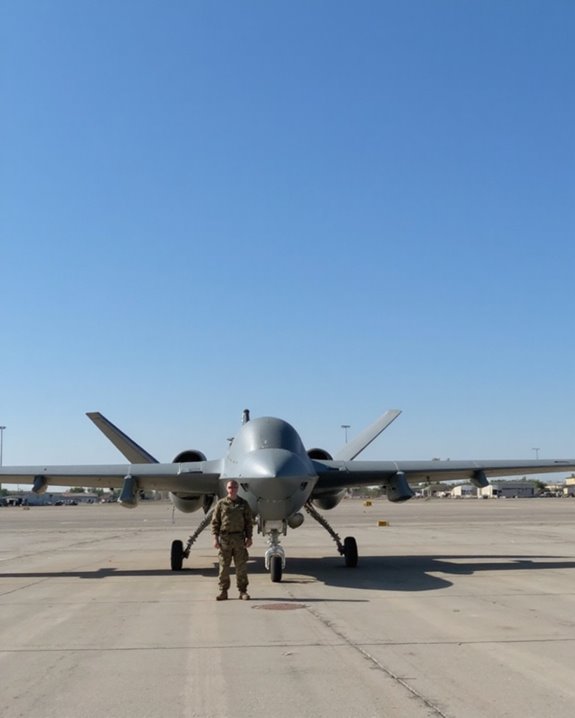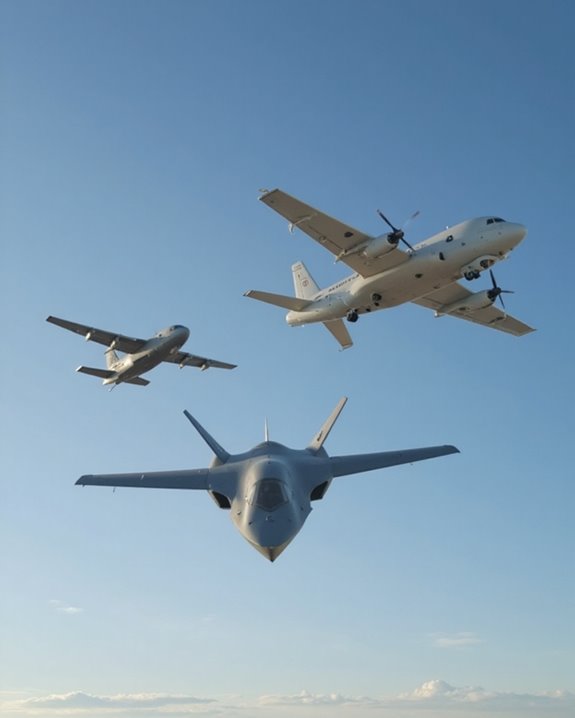Military drones come in various shapes and sizes, from sleek fixed-wing Predators with their distinctive twin-boom tails to compact quadcopters used for close reconnaissance. Most feature muted color schemes (desert tan or matte black) and prominent sensor turrets underneath. Their designs range from early wooden contraptions to today’s carbon fiber marvels with advanced stabilization systems. You’ll spot hardpoints for weapons on larger models and sophisticated cameras that can see for miles—even in complete darkness!
Key Takeaways
- Military drones feature aerodynamic designs with fixed wings or multiple rotors, often in muted colors like desert tan or matte black.
- Most models have distinctive twin-boom tails, protruding sensor turrets, and visible hardpoints for weapons on larger variants.
- Size ranges from micro-drones under 2kg for reconnaissance to heavy-lifters exceeding 1,000kg for substantial payload delivery.
- Modern military drones incorporate carbon fiber frames, advanced stabilization systems, and 3-axis gimbals for steady operation.
- Surveillance capabilities include electro-optical systems up to 45 megapixels, infrared sensors for night operations, and integrated radar systems.
Distinctive Physical Characteristics of Military Drones
The world of military drones boasts a fascinating array of distinctive physical characteristics that set these unmanned aircraft apart from their civilian counterparts. These airborne marvels typically feature aerodynamic designs with either fixed wings for endurance or multiple rotors for versatility. Unlike their civilian relatives, military drones often sport muted Paint Schemes in desert tan, slate gray, or matte black to minimize visibility!
The most recognizable UAVs, like the Predator, display distinctive twin-boom tails and protruding sensor turrets underneath their fuselage. You’ll notice subtle Insignia Designs that indicate nationality without compromising stealth capabilities. Larger models showcase visible hardpoints for weaponry, while smaller tactical drones might be barely larger than a dinner plate. Their composite materials and faceted surfaces aren’t just for durability—they’re engineering triumphs designed to confuse enemy radar systems. Additionally, many military drones incorporate radar cross-section minimization techniques to enhance their stealth in hostile environments.
Evolution of Military Drone Design Through the Years
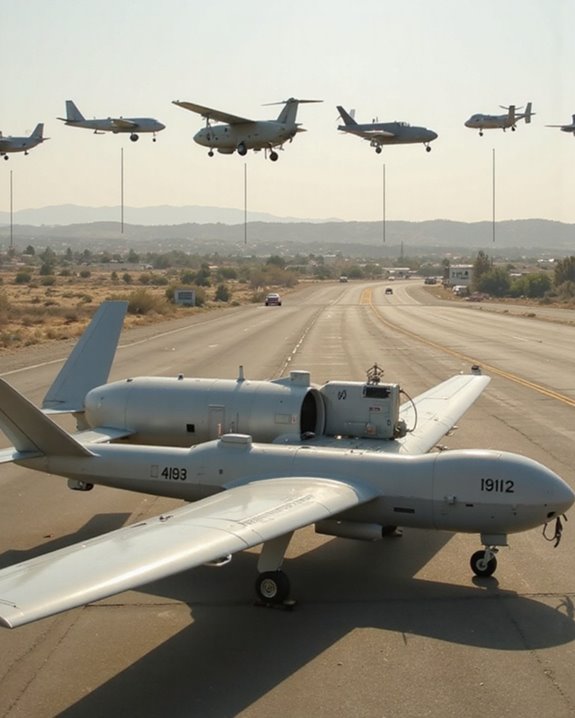
Throughout history’s relentless march forward, military drone design has undergone a fascinating metamorphosis, evolving from humble wooden contraptions to today’s sleek, high-tech marvels! Those early 1890s models, built from spruce and plywood, would barely recognize their carbon fiber descendants.
The interwar period saw significant advances with the de Havilland Queen Bee leading the charge. As Funding Impacts increased post-WWII, designs shifted dramatically from simple radio-controlled aircraft to sophisticated autonomous systems. Policy Changes in the late 20th century accelerated this transformation, pushing military contractors to develop multi-role platforms capable of reconnaissance, surveillance, and combat operations.
Today’s military drones—with their AI integration, electric propulsion systems, and enhanced cybersecurity—represent the cutting edge of aerospace engineering. Who knew those primitive target drones would eventually become the cornerstone of modern warfare? The RQ-11 Raven UAV, with its exceptional portability and battle-tested design, exemplifies the evolution toward highly reliable and versatile military drone platforms.
Structural Components That Define Military UAVs
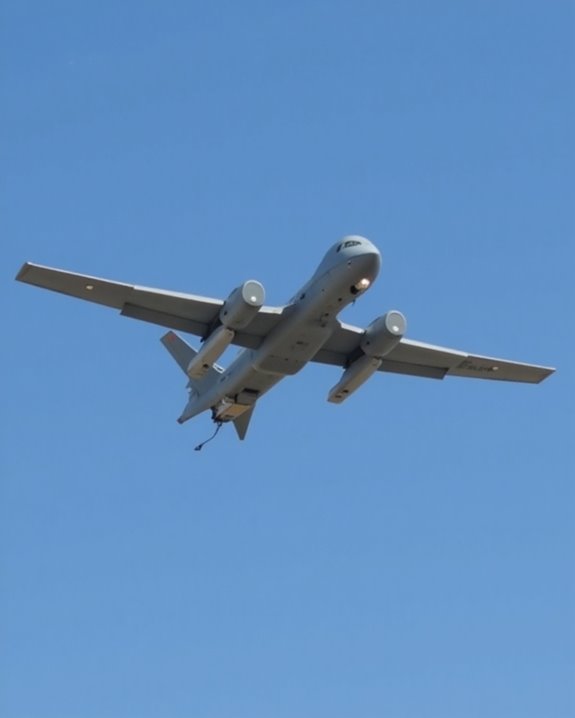
Modern military drones owe their impressive capabilities to carefully engineered structural components that work in harmony to create these aerial marvels! The foundation is the frame, typically crafted from carbon fiber composites that provide exceptional strength-to-weight ratios while incorporating Vibration Dampening features to protect sensitive electronics.
The chassis design focuses on Load Distribution, ensuring each component—from propulsion systems to control elements—maintains perfect balance during flight operations. You’ll find most military UAVs sporting carefully designed arm configurations that house powerful motors and specialized propellers at their ends. What’s amazing is how these structural elements must accommodate everything from navigation sensors to communication systems while remaining lightweight enough to fly efficiently! The marriage of titanium, aluminum, and advanced composites creates drones that are both durable and agile—ready for whatever mission comes their way. Many models also incorporate advanced stabilization systems, including 3-axis gimbals, to ensure steady footage during tactical maneuvers.
Size and Weight Classifications of Combat Drones
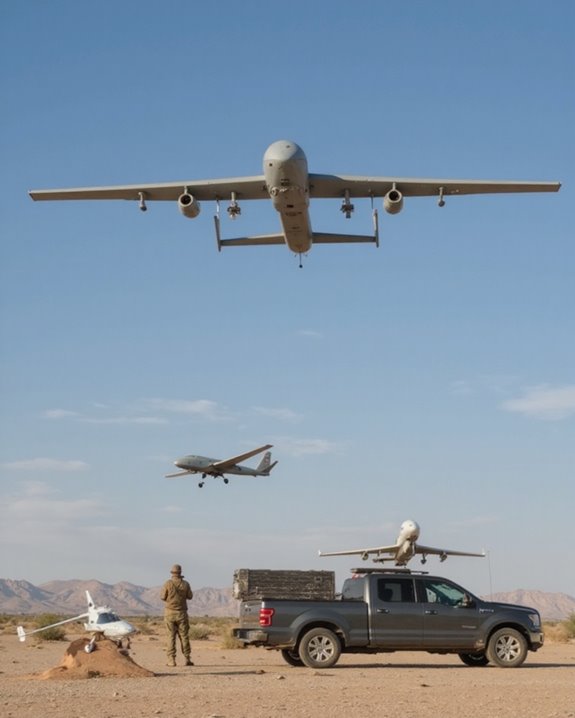
Military drone classifications follow a sophisticated hierarchy based primarily on size and weight specifications—essential factors that determine their operational capabilities and mission parameters! The Size Standards range from featherweight micro-drones weighing under 2 kg—perfect for tight-space reconnaissance—to behemoth heavy-lifters exceeding 1,000 kg that can deliver substantial payloads.
The Weight Economics of these UAVs directly correlates to their mission profiles: Class I drones (under 150 kg) include micro, mini, and small variants for tactical surveillance, while Class II systems (150-600 kg) offer enhanced endurance and payload capacity. Imagine a drone the weight of a paperclip compared to one heavier than a grizzly bear! Mid-weight systems carrying 40-150 kg payloads strike that sweet spot between portability and capability—the “Goldilocks zone” of military drone design!
Advanced Surveillance Technology and Visual Elements
How do surveillance drones manage to see what human eyes cannot? The answer lies in their remarkable sensor arrays! Military drones utilize electro-optical systems that can reach a staggering 45 megapixels, providing crystal-clear imagery for Ethical Surveillance operations.
The game-changing Argus system, with its 1.8 gigapixel sensor (originally derived from smartphone technology), can track individuals with pinpoint accuracy from thousands of feet above. Visual AI algorithms analyze this data, identifying patterns of life and movement that would be impossible for human operators to detect manually. At night, these mechanical eyes switch to infrared mode, turning darkness into day!
Drones equipped with multiple sensor types—radar, RF detectors, and laser telemetry—create a detailed surveillance picture that extends far beyond what any human observer could achieve.
Stealth Features and Concealment Capabilities
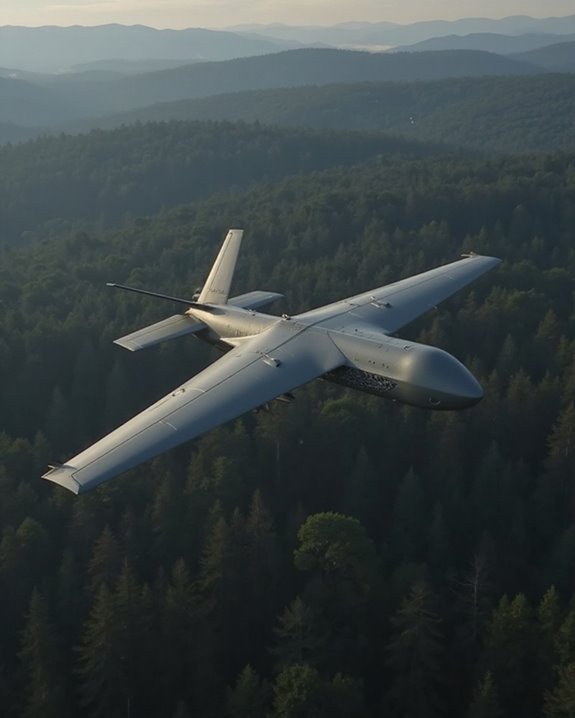
Why do military drones seemingly vanish from radar screens? The answer lies in their remarkable stealth design principles. Flying wing configurations, like those in the RQ-170 Sentinel, dramatically reduce radar visibility by eliminating unnecessary surfaces. These aircraft utilize faceted surfaces that deflect radar waves, much like a gemstone face scatters light!
Advanced Radar-Absorbent Materials (RAM), including graphene and carbon fiber composites, work alongside Infrared Suppression systems to mask heat signatures. Modern drones feature internal weapons bays, serrated edges, and rounded contours that contribute to their ghostly presence. Many advanced models incorporate Acoustic Cloaking technology, dampening engine noise for silent operation.
The combination of flush fuselages, recessed exhaust systems, and specialized polymer coatings makes these aerial phantoms nearly invisible to conventional detection methods. Isn’t it fascinating how something so technologically complex can be designed to simply disappear?
Weapons Systems and Their Integration Into Drone Design
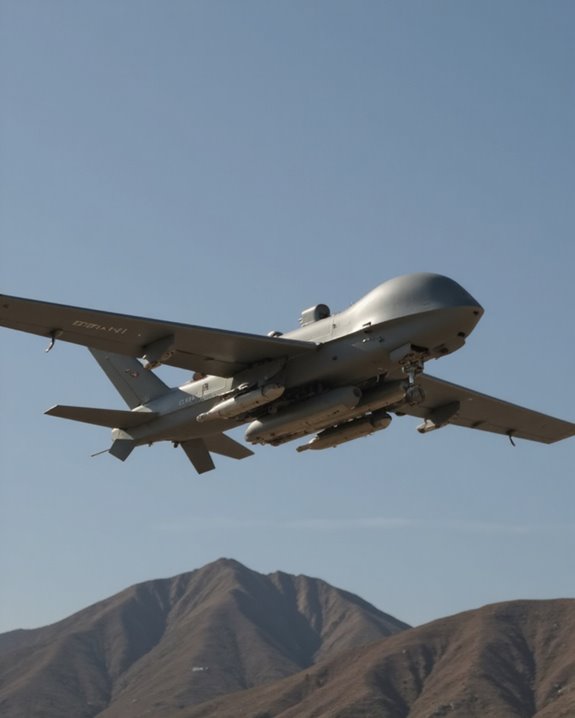
While concealment keeps drones hidden from enemy detection, their true purpose emerges through the weapons they carry. Modern military drones integrate a variety of Munition Types that leverage standardization with existing military stockpiles, reducing the need for drone-specific ammunition. This brilliant strategy allows familiar munitions to be seamlessly incorporated into drone operations!
Integration Strategies focus on compatibility across different branches and allied forces, enhancing operational flexibility in combat situations. Drones now carry everything from precision-guided bombs to long-range missiles, with AI-assisted targeting systems that can autonomously identify and lock onto objectives. These weapons aren’t just bolted on as afterthoughts—they’re carefully incorporated into the drone’s design to maintain aerodynamic properties while maximizing destructive potential. The marriage of advanced AI and traditional munitions creates a formidable combination that’s transforming modern warfare.
Material Composition and Durability Factors
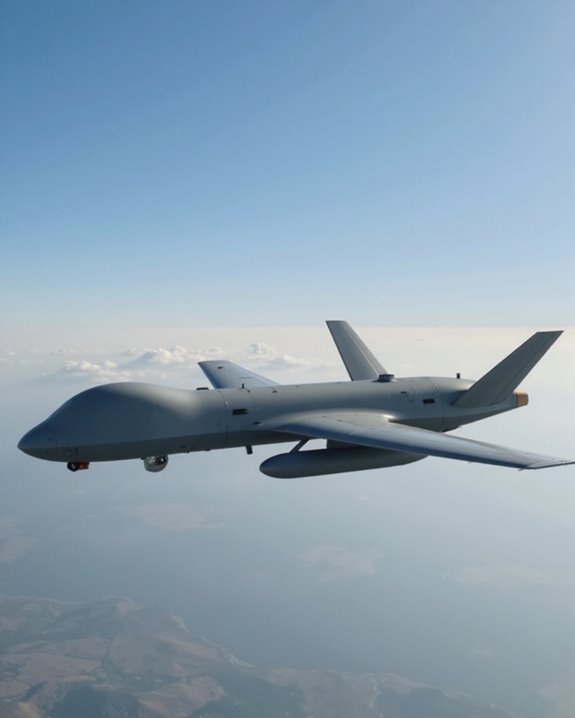
The remarkable composition of modern military drones represents a triumph of materials science and engineering ingenuity! Carbon fiber reinforced polymers (CFRP) dominate drone airframes, providing exceptional strength-to-weight advantages while simultaneously enhancing stealth capabilities by absorbing radar waves. These wonder materials not only outperform traditional metals in durability but also offer superior environmental impact throughout their lifecycle assessment.
Manufacturers employ honeycomb composite structures that maximize strength while minimizing weight—imagine a beehive design but engineered for flight! The lightweight materials must withstand operational stresses without failing, which is why specialized thermosetting resins create bonds that remain stable even in extreme conditions. What’s truly impressive is how these composites require fewer inspections than metal structures, reducing maintenance needs and extending operational availability. Talk about getting more bang for your defense buck!
Control Mechanisms and Their Visible Components
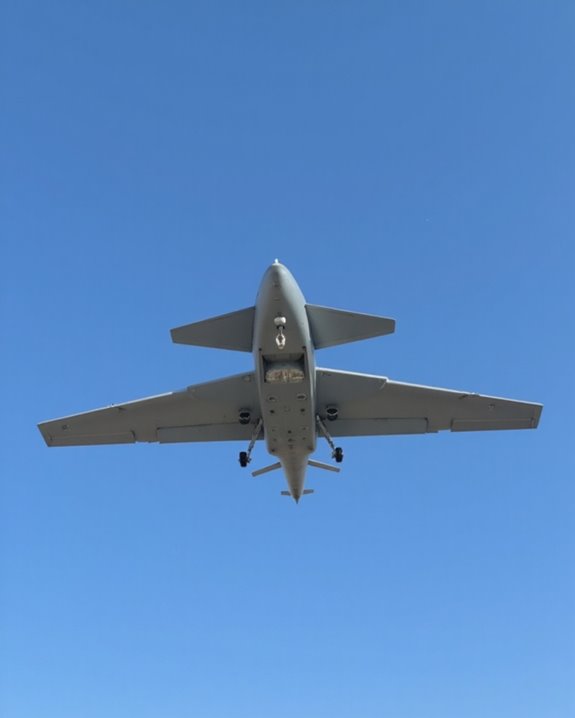
Control mechanisms of military drones represent marvels of engineering that enable these sophisticated machines to perform complex maneuvers with precision! The exterior of these aerial vehicles features numerous visible components that serve essential functions. Antennas and sensor arrays dot the surface, while LED indicators and status lights provide quick visual feedback about operational conditions. You’ll notice these colorful lights blinking during flight operations, signaling everything from battery status to communication connectivity.
Ground control stations, the drone’s command center, feature impressive arrays of screens, joysticks, and communication equipment. These stations process real-time data while operators monitor various parameters. The integration of autonomous systems means fewer visible controls on the drone itself, with GPS modules and IMUs tucked neatly inside the frame—making today’s military drones sleeker and more streamlined than their predecessors!
Comparing Military Drones Across Global Powers
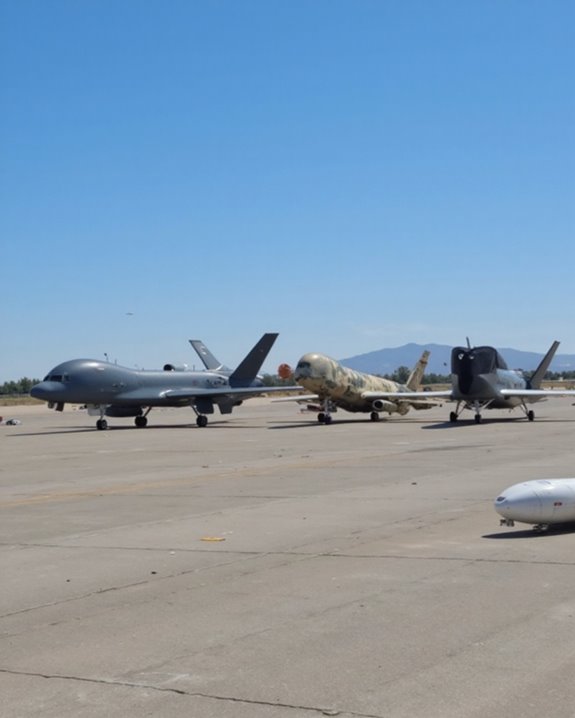
How do global powers stack up against each other in the race for unmanned aerial superiority? China’s Wing Loong II, with its impressive 32-hour endurance, draws clear inspiration from America’s mighty MQ-9 Reaper, creating interesting dynamics in Drone Alliances across Asia and Africa. The U.S. maintains its edge with the Reaper’s massive 1,749 kg payload capacity, while strictly managing Export Controls to limit proliferation of its advanced technology.
Europe’s collaborative Eurodrone project reflects a different approach – pooling resources rather than competing individually! Meanwhile, Turkey’s Bayraktar TB2 has become a surprise star in recent conflicts, despite carrying just 150 kg of munitions. Russia’s secretive Orion-E rounds out the major players, though they’re particularly tight-lipped about its specific capabilities, making it the mystery drone of the bunch.
Frequently Asked Questions
How Are Military Drones Protected Against Extreme Weather Conditions?
Beneath their armored exteriors lies a secret. Military drones employ sophisticated thermal insulation systems against temperature extremes, while specialized aerodynamic designs enhance wind resistance, enabling operation through storms, sand, and snow.
Can Civilians Legally Own Replicas of Military Drones?
Civilian ownership of military drone replicas is legal, provided these legal replicas comply with FAA regulations, lack weaponry, maintain Remote ID broadcasting capabilities, and don’t incorporate restricted military technologies like jamming equipment or electronic warfare systems.
How Do Military Drones Handle Electromagnetic Interference?
Like fortresses against invisible threats, military drones employ advanced EMI hardening techniques including signal filtering, protective enclosures, and metallized polymer shields. They utilize frequency-specific protection and adaptive technologies to maintain operational integrity in hostile electromagnetic environments.
What Emergency Landing Systems Do Military Drones Employ?
Military drones employ parachute mechanisms for controlled descents and maintain fuel reserves to reach safe landing zones. They also utilize autonomous navigation systems and health monitoring to detect failures requiring emergency landings.
How Do Military Drones Avoid Detection by Civilian Radar Systems?
Military drones avoid civilian radar detection using stealth technology and radar absorbent materials. They employ low-altitude flights, frequency hopping, signal jamming, and utilize natural terrain features to minimize their radar cross-section.


